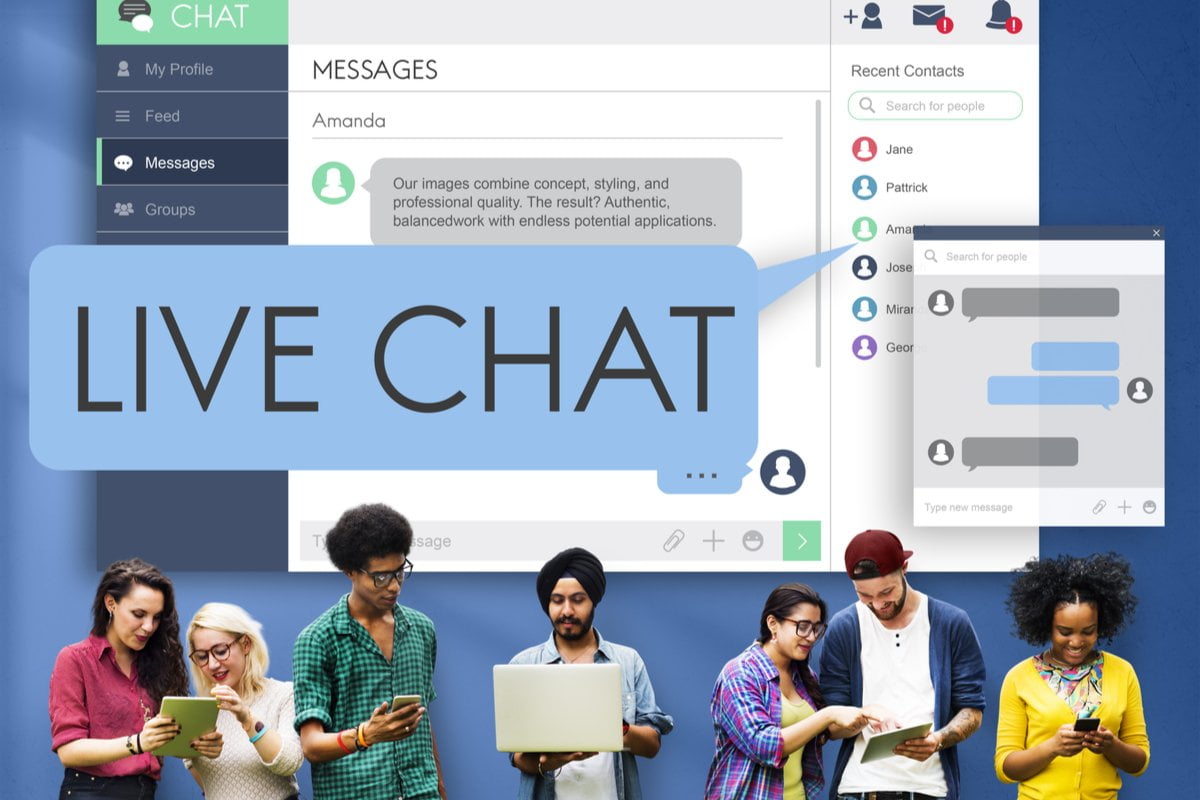Digitize your customer service for 100 percent customer satisfaction
This is a custom heading element.
Digitalization is still a fear for some contact center managers. A shame, because digitization offers you precisely the opportunity to achieve one hundred percent customer satisfaction.
Embrace digitization
Embracing digital opportunities presents tremendous opportunities for businesses, reads this article on MarketingTribune. As many as eighty percent of consumers use mobile devices to search for information, reviews and prices before making a purchase, 65 percent of them do online research before visiting a store. Three-quarters use reviews before proceeding to purchase a product. This is forcing companies to put their customer experience under the magnifying glass once again. To achieve optimal customer service – and therefore an optimal customer experience – you have to digitize. Companies that have a strong omnichannel environment achieve retention rates as high as 89 percent.
Connected 24/7
An example. As recently as 2013, a forty-something woman preferred telephone contact with a company’s customer service, and 84 percent of people with her. Today, a customer with the same profile will prefer email or social media. Phone remains important, but the percentage who prefer to use the phone has dropped by about 40 percent. Because today you are connected to your customers 24/7, customer service has become more complex. By digitizing, you can significantly improve your customer experience because it allows customers to contact you – or find the answer to a question – even when your call center agents are not at work.
Personalized relationship with your customer
So to achieve optimal satisfaction, you need to create a solid digital strategy. Choose the right channels, consider customer behavior and offer your customers a seamless customer journey. Not only will it strengthen your brand image and increase customer loyalty, but it will also help you stand out from the competition. Digitization allows you to put your customer first and build and maintain a personalized relationship. Of course, this means that your agents also need to be understanding to people who are not yet as far along. After all, every customer needs to feel heard.
Rely on an omnichannel strategy
Digitization and an omnichannel strategy gohand in hand. An omnichannel strategy is at the heart of digitizing customer service. Your customer wants to be able to use every channel, without compromising on customer friendliness: research on your website, contact via chat or WhatsApp, a phone call, every time, employees must be fully informed about all the information about this customer. Knowledge of your customer is vital when it comes to loyalty, and service quality is essential. Therefore, digitization and quality assuranceshould alwaysgo hand in hand. That way, the customer experience gets a little better every day. On to that one hundred percent!
Curious?
About twenty years ago, we started supporting call centers. By now, most call centers have evolved into contact centers. We have included all the knowledge, skill and experience of the past two decades, which ensures that our solutions are not only smart and stable, but also provide the optimal customer experience. Want to know more? Then contact us without obligation. We will gladly work with you to find the ultimate solution for your organization. Want to get acquainted first? Stay informed by signing up for our newsletter.
Customer voice is key to customer satisfaction
This is a custom heading element.
To retain your customers, you have to know very well what they want. To know what your customers want, you have to listen to them. A Voice of the Customer analysis helps with that. What is a VOC analysis and what should you pay attention to?
Customer Loyalty
Companies are constantly looking for ways to improve their products and services in hopes of increasing customer loyalty. To achieve that, you need to know exactly what your customers want. According to the Salesforce State of the Connected Customer report, 80 percent of customers consider brand engagement as important as product quality, and 53 percent say they feel an emotional connection with the brands they buy from most often. Incredibly important, then, to listen to your customers’ opinions – the positive ones, as well as the not-so-positive ones.
VOC Analysis
According to Lean Six Sigma, a VOC analysis is the translation of your customers’ voice (feedback) into concrete requirements that the organization must meet. A VOC analysis helps to know how to get and maintain good customer satisfaction. So VOC is a term that describes the process of capturing and understanding customers’ preferences, expectations, disappointments and overall sentiment about their experience with brands by collecting feedback in various ways. When brands invest in VOC, they can offer products and services that make their customers happy. This way, you can create an optimal customer journey and ultimately increase customer loyalty.
How do you measure your customer’s voice?
VOC can be measured in several ways, we mention three in this blog.
1. Surveys
You can ask customers to complete a survey at any point in the customer journey. You can send short surveys to customers while they are on your website, after making a purchase, or collect feedback on service interactions.
2. Social listening
Customers talk a lot and often about brands on social media, and as a company you can learn a lot from that. Social listening is described on the Frankwatching site as “following and monitoring all the conversations around your organization, brand, product, target audience or industry and turning this online buzz into data and advice that you can do something with. So by gathering information from social media platforms, blogs, online forums and review websites, you can uncover customer pain points that need to be addressed, as well as identify positives that you can use to improve customer loyalty.
3. KPIs and service transcriptions.
You can also view or listen to transcripts of customer service contact moments to gain insight into how customers felt during their interactions. This also helps you discover why customers contacted you in the first place. KPIs such as CSAT, NPS and CES are also indications about customer sentiment with a brand.
Better customer experiences thanks to VOC
So VOC can be used to improve the customer experience. Here are the steps to take.
1. Consistently collect real-time customer feedback across all channels and after every interaction
This feedback allows you to continually evolve your brand to continue to meet current customer needs.
2. Pay attention to specific KPIs
NPS, or Net Promoter Score, shows whether customers are willing to recommend your brand to others. CES, or Customer Effort Score, shows how much effort customers have to put in to get something done as your customer. The higher the score, the more effort the customer has to put in. Finally, Customer Satisfaction Score (CSAT) measures overall customer satisfaction with your brand.
3. Follow-up
By using surveys, you can learn if customers are satisfied with the products or services they have purchased. Above all, don’t forget to also contact dissatisfied customers to determine what steps you can take to improve the customer experience in the future.
4. Create an action plan
As an organization, create an action plan to ensure that each department is doing its best to increase customer satisfaction. This could include: optimizing an omnichannel strategy to ensure a seamless customer journey, improving existing products, improving communication methods between departments and training your service agents to update their product knowledge and practice empathy for better service.
So listen …
By being open to what customers are saying and feeling about your brand, you can create the kind of customer experiences that customers are looking for. That will give you a competitive advantage and increase customer satisfaction and customer loyalty. Our Hermes360 solution is an intuitive, omnichannel and AI-ready cloud contact center solution that helps you deliver that exceptional customer service, increase agent productivity and maximize the effectiveness of your outbound call campaigns.
Curious?
About twenty years ago, we started supporting call centers. By now, most call centers have evolved into contact centers. We have included all the knowledge, skill and experience of the past two decades, which ensures that our solutions are not only smart and stable, but also provide the optimal customer experience. Want to know more? Then contact us without obligation. We will gladly work with you to find the ultimate solution for your organization. Want to get acquainted first? Stay informed by signing up for our newsletter.
Quality assembling your call center time consuming? It really isn't!
This is a custom heading element.
Customer experience is more important than ever. It is everything that determines the success of your organization and your products or services. With a well-functioning contact center, you can respond ever better to your customer’s needs. This will make your customer contact efficient, affordable and profitable. Time-consuming? Not if you do it right.
Cumbersome quality monitoring creates pressure
Today, team coaches within a contact center have many different tasks. Real time for quality monitoring often slips away. If this quality monitoring is organized in a cumbersome way, it only adds to the pressure. Yet good quality monitoring brings many advantages.
Benefits of quality monitoring
1. It helps you track an employee’s progress and you can tailor your coaching calls and training to the employee’s level and needs.
2. It allows you to give your employees targeted feedback – both positive and constructive.
3. It clarifies which topic is important to multiple employees, so you can organize a group training or e-learning for that.
4. It gives you tools to assess and coach all employees in the same way on targeted topics. This motivates your employees to improve and prevents staff turnover.
The added value of smart quality monitoring
Of course, you can spend entire days sitting next to your employees listening in on conversations and filling out forms. That only creates more pressure. By choosing a smart solution that makes use of artificial intelligence and also integrates the world of quality monitoring with the world of customer research, you make things a lot easier for your coaches. With Quality Monitoring from Contact Center Live, you offer your agents the right tools to continuously improve. Here are six of the pluses in a row.
1. Depending on department, employee profile or brand and label, you can create one or more assessment forms, in which you can assign a weighting factor for each question.
2. As a coach, you get access to your own portal where you can easily evaluate, play audio files and track results.
3. Coaches – or team leaders, management and supervisors – can assess their agents’ conversations based on call recording and assessment forms. This can be done while completing the assessment form. These ratings can be qualified between evaluators, so that you have one yardstick for all coaches and all agents are evaluated uniformly.
4. After completing the assessment form, you can send it directly to the employee in preparation for the coaching interview.
5. Whether you work with several call centers or a single one, all results come together in a clear reporting module, within which you can easily distinguish between quality results of departments, teams or even different locations and external partners.
6. Because the process is clearly structured, you increase the number of conversations
Want to know more?
Our Quality Monitoring is a solution that pairs independently of your contact center solution with Contact Center Live’s Quality Monitoring. Want to know more? Please feel free to contact us. We will gladly work with you to find the ultimate solution for your organization. Want to get acquainted first? Stay informed by signing up for our newsletter.
Call center or contact center: what's the difference?
This is a custom heading element.
An optimal customer experience determines the success of your organization and your products or services. Excellent customer service is of course indispensable in this regard. In the past, this was usually managed by a call center where agents handled telephone requests. Meanwhile, more and more call centers are transforming into contact centers. The objective is still to deliver the best possible customer experience, but what is the difference? And what does that mean for your organization?
What is a call center?
A call center is a department or organization that specializes in handling telephone traffic. This concerns inbound and outbound telephone traffic. Characteristic of a call center are the large number of call center employees, the strict division of tasks, the central control and the high efficiency.
How do call centers work?
A call center can be cloud-based, or one can opt for an on-premises solution. In the latter case, all software and hardware is on the physical premises and agents are always working on-site. Cloud-based call centers are hosted in the cloud by a third-party call center software provider. This provider sets up and maintains the software and provides technical support to agents as needed. Cloud-based call centers allow agents to work remotely with only a functioning Internet connection.
Incoming and outgoing
Call centers that handle incoming calls deal with a variety of customer inquiries. These may be technical support or product information or questions about billing, delivery or scheduling appointments. In this case, agents are focused on responding to requests as quickly as possible to maximize productivity and customer satisfaction. Call centers that handle outbound calls do so because of sales, marketing, survey or collection purposes.
Four advantages of a modern call center
1. Managing high call volumes
Call center agents work through one channel and can concentrate on handling as many calls as possible through that one channel. Since all agents are trained to work through that channel, they can provide the same quality. If call volume increases during peak hours, more agents can easily be added. Cloud-based call centers are particularly scalable because agents working remotely can also be deployed very simply.
2. Provide faster and more efficient service
Technology such as a modern IVR can quickly and efficiently transfer callers to the best qualified agent available. An IVR can also be used for self-service, such as checking an account balance or delivery status. Callback capabilities eliminate the need for a customer to wait in line.
3. Reduce costs
Call centers are generally cheaper to maintain than contact centers. Cloud-based call centers offer more cost advantages than on-premise call centers because agents can be added quickly without the need for additional hardware.
4. Track progress of agents
Real-time dashboards and reports provide insight into agent performance, allowing companies to continuously improve their call center practices.
How does our Hermes 360 solution contribute?
With our Hermes environment, even with the challenges of ever-changing laws and regulations, you can create a very successful campaign for clients. For example, this solution is equipped with a powerful, predictive outbound dialer and smart reporting capabilities.
What is a contact center?
Contact centers have the same goals as call centers, but unlike call centers, they manage multiple communication channels to provide customers with an omnichannel experience. In addition to phone, contact centers can deploy text messaging, social media, email, live and video chat, which are unified in a single contact center software platform.
How do contact centers work?
Contact center agents can handle both inbound and outbound contacts. Media blending, for example, allows an agent to manage an incoming chat from one customer and then send a text message or e-mail to another. For outbound contacts, a contact center can choose to prioritize different channels for different purposes. Order confirmations and delivery status notifications can be sent by e-mail, while technical support can be provided via chat or phone. Contact center solutions are typically integrated with a CRM system to provide a complete picture of the customer. Agents can access and update customer information such as interaction history and previous purchases in the CRM. Contact centers can also be cloud-based, allowing for easy flexibility and scalability as a company’s needs change. Agents can work remotely with access to all features of the contact center solution.
Four benefits of a modern contact center
1. 360-degree customer view
When contact centers are integrated with a CRM, agents can understand the full customer context. This allows them to easily manage customer requests without asking customers to repeat information. They can also use this customer knowledge to make relevant up-selling, cross-selling and service offers. Personalized service is valued by all customers.
2. Meeting customer preferences.
Omnichannel contact centers can accommodate customers through their preferred channel. At a modern contact center, customers have a seamless experience when switching from one channel to another because agents can always access their history in the CRM system and resume the conversation where it left off.
3. Faster, proactive service and better customer experiences.
Real-time KPI dashboards and activity reports provide valuable insights that can improve agent efficiency and thus customer experience. For example, companies can better understand common reasons for service requests and proactively resolve issues. They can also track customer behavior, such as website navigation, so they can proactively contact them through channels such as live chat. Advanced ticket routing and task automation also save agents time and help them provide faster solutions to customers.
4. Integrate AI for stronger self-service
AI-powered chatbots can be used to help customers with simple requests. They can also manage the first steps of a request and transfer the customer to an agent if necessary.
How does our Hermes 360ossing contribute?
Our Hermes360 solution provides not only agility and flexibility, but – as the name suggests – a 360-degree view of all contacts. This allows you to use modern IVR technology for incoming communications – via any channel. Phone, email or chat? Everything comes in centrally and is routed to the right employee. If you need to respond quickly to your customers’ needs, you can make real-time adjustments without having to restart the software. Reversing queues, transferring calls to external call centers? No problem! Thanks to predictive data analysis, you can better design your campaigns in advance.
Choosing not necessary
With a good solution, there is no need to choose between a call center and a contact center. Our Hermes360 solution is an application that can do both types of centers. Separately or combined. It’s an intuitive, omnichannel and AI-ready cloud contact center solution that helps you deliver exceptional customer service, helps increase agent productivity and maximizes the effectiveness of your outbound call campaigns.
Curious?
About twenty years ago, we started supporting call centers. By now, most call centers have evolved into contact centers. We have included all the knowledge, skill and experience of the past two decades, which ensures that our solutions are not only smart and stable, but also provide the optimal customer experience. Want to know more? Then contact us without obligation. We will gladly work with you to find the ultimate solution for your organization. Want to get acquainted first? Stay informed by signing up for our newsletter.
A customer service vision that works? Here's how to do it!
This is a custom heading element.
From research shows that customers want a simple, quick solution to their problem. To keep meeting that need, you must establish a vision for customer service that is viable. Setting a vision is one thing. In this blog, we’ll tell you what else to look for.
Irresistible customer service essential
A good product or high-quality service alone won’t get you there these days. If you want to retain customers, irresistible customer service is essential. Research by Zendesk shows that half of all customers go to a competitor after just one bad experience. Three quarters, on the other hand, are willing to spend more money if you offer a positive experience. So your customer service is the best way to differentiate yourself. The fact that far from every organization can pull this off indicates that it is not as simple as it seems. By creating a good customer service vision, you make it a lot easier on yourself. It starts with a realistic plan, concrete goals and inspiring values that your team can relate to.
Connect your own values to trends
A good vision for customer service gives your employees something to hold on to, with every new customer contact. It reflects your customer’s needs, your organization’s values and mindset, and gives a clear picture of your goals. In addition to your own values, of course, it is also important to pay attention to trends. For example, it appears that 69 percent of customers highly value self-service solutions, such as live chat, social messaging, a help center or peer-to-peer communities. Who wants to stand in a queue to speak to an employee today? Yet less than a third of companies offer self-service channels. So, room for improvement.
In practice: Apple’s customer service vision
Apple employs a handy acronym when it comes to providing a handle on customer service employees:
- ‘Approach’ – Welcome your customers in a warm and personal way.
- ‘Probe’ – Probe exactly what the customer is looking for.
- ‘Present’ – Offer a solution that your customer can apply immediately.
- ‘Listen’ – Listen to objections or problems and find a solution.
- ‘End’ – End the contact with a pleasant farewell and invitation to feel free to visit again.
Connects to daily work
If you’re working to create a good customer service vision that will benefit your employees, connect to the actions your people take every day to keep your customers happy. This doesn’t have to be in the form of such a clever acronym, of course, but make sure you have easy-to-remember verbs that your people can remember well. And above all, don’t forget to ask your employees for their input. After all, they do the work; they have the most valuable input. This can be done, for example, through – online – meetings, evaluation forms, suggestion boxes, questionnaires, one-on-one conversations. This way you not only get the best ideas, you also create more support.
Include the entire organization
The employees on your customer service team are at the forefront of customer contact. But don’t forget that every department plays a role when it comes to a good customer journey. From the purchasing department to marketing to the tech department to HR staff. Perhaps most importantly: the management team. Every employee is watching how management is doing. So set a good example by making customer service a priority and by consistently following your own vision in it.
Good listening
The most important thing when getting started with a customer service vision is to look closely at your customer. Unfortunately, there are no ready-made formulas; every customer and every organization needs something different. Listen to your customers, listen to your employees and set a vision that sets your company apart.
Curious?
That ideal customer journey, the optimal customer experience, is the primary factor by which you can differentiate yourself from the competition. It determines the future sustainability and success of an organization, both in the short and long term. Do you also want to stand out in the market? Then contact us without obligation. We will gladly work with you to find the ultimate solution for your customer contact center. Want to get acquainted first? Stay informed by signing up for our newsletter.
Sparkle into the new year with your KCC! What do you do that with?
This is a custom heading element.
A whole new year full of possibilities lies ahead of us. If you’re looking forward to it as much as we are, it’s sure to be a sparkling 2022. These five tips will help your customer contact center employees shine.
1. Turn your support person into a super agent
Combining a good support employee with the right technology creates superpowers that help your customer super fast and very efficiently. From self-service technology to continuous learning systems and from emotional intelligence to the right adaptability, with the right superpowers your support employee will blow your customer’s mind in 2022.
2. Transform the customer experience with a modern IVR
Phone menus, that’s really very 2021. Modern smart IVR, that’s in a different league. No hassle for the customer, no hassle for the employee, shorter menu choices and so on. By deploying a smart, modern IVR, you can make your brand image go through the roof in 2022.
3. Improve the customer experience with live chat support
People today are increasingly choosing live chat. Online, the need for quick and personal contact is growing, especially among millennials. Live chat not only improves the customer experience, it also increases employee productivity. 2022 is the year to integrate chat into your call center.
4. Manage your time efficiently
The customer contact center is your company’s business card. It is at least as important as your store counter or reception desk, even if the contact is not physical. By choosing an adequate solution, and streamlining your processes, you will ensure that your customers are satisfied and stay that way. In 2022, it’s time to put your employees to work pieces more efficiently and effectively.
5. Make sure your call center continues to deliver a personalized and seamless customer experience beyond 2022
Hybrid working, the cloud, artificial intelligence, omnichannel and then you also have to be empathetic and personal. These are the trends you have to deal with as a customer contact manager to be ready for the future.
Stepping back for a moment
With all kinds of new channels, functionalities and different help desk software vendors, you could easily get lost. This sometimes makes choosing a solution that suits you more complex than necessary. Time to go back to basics. From there you can slowly rebuild so that 2022 will still be your year!
Here’s to a beautiful 2022!
We wish all customers, employees and associates a very beautiful, sparkling and healthy 2022 and look forward to working with everyone to create many great customer journeys. Could you use some help with that? Please feel free to contact us. We will gladly work with you to find the ultimate solution for your customer contact center. Want to get acquainted first? Stay informed by signing up for our newsletter.
Here's how to turn your support employee into a super agent
This is a custom heading element.
A superhero cannot go through life as a superhero twenty-four hours a day. Clark Kent, Superman’s secret alter ego knows all about it. Unfortunately. Even your support staff looks very ordinary most of the day, but under those neat office clothes – or that comfortable house suit – is a super agent. Combining a good support agent with the right technology creates superpowers that help your customer super fast and very efficiently. Here are the 8 most important superpowers.
1 Self-service technology
With self-service technology, knowledge base articles can be searched quickly and easily. Couple customer and order data with that and mix that with a sauce of smart chatbots, and your customer almost has his or her question answered before the question has even been asked.
2 360-degree view
If it is a really complex issue or if the customer asks for a flesh-and-blood employee for any other reason, then that employee gets all the relevant information from the customer right in front of his nose. This way, the employee has a 360-degree view of the customer and can almost fill in the customer’s question – and answer it immediately!
3 Continuous learning system
A superagent is constantly learning. Articles are updated by employees and published after review by the manager. Changed and new articles are actively brought to the attention of your employees, allowing them to get up to speed faster and find relevant information at lightning speed. This not only benefits your employees, but also the customers who use the self-service functionalities.
4 Emotional intelligence
A super agent not only provides exceptional service, he or she is also characterized by a highly sensitive empathy sensor. Every super agent has a high EQ and is very adept at handling emotionally charged situations well, avoiding them and ensuring successful conversational outcomes. Empathy is an essential skill for anticipating and responding to customer questions and needs.
5 Multitasking
Multitasking doesn’t work? With a super agent it does! Nowadays a lot is asked of a support employee. He or she must use all superpowers to keep up with everything that’s going on while ensuring quality. More than ever, multitasking and handling interactions across multiple channels – and doing it well – is a crucial part of contact center workers’ work.
6 Drive to take own initiative
In addition to good support systems, a support person must also be given – and take – the space to develop their own initiatives and rely on their own knowledge. There are always problems or issues that cannot be captured in a knowledge base article or procedure. By combining the knowledge base articles with the right procedures ánd the employee’s own initiative, complex issues are solved in the most professional way.
7 Team player
Just as Clark Kent had to cooperate with Lois Lane, a super agent must also understand the value of good cooperation. Knowledge is power, but sharing is strength. The super agent understands this and shares his knowledge with colleagues so that it reflects on the entire department and benefits the customer. By encouraging your employees as department managers to share new solutions and discoveries with each other, you create even more super agents.
8 Adaptability
Applications are adapting more often and faster, and new features appear before your eyes. To do this, a super agent must constantly call on his adaptability and will quickly master it. Often faster than you think…
Curious?
That ideal customer journey, the optimal customer experience, is the primary factor by which you can differentiate yourself from the competition. It determines the future sustainability and success of an organization, both in the short and long term. Do you also want to stand out in the market? Then contact us without obligation. We will gladly work with you to find the ultimate solution for your customer contact center. Want to get acquainted first? Stay informed by signing up for our newsletter.
How live chat support improves the customer experience
This is a custom heading element.
People today are increasingly choosing live chat. Online, the need for quick and personal contact is growing, especially among millennials. Live chat not only improves the customer experience, it also increases employee productivity. Time to integrate chat into your call center.
Response speed
Customers today choose live chat more than they did a few years ago. The response speed is many times faster than e-mail and this way the phone remains available for other things, be it work or private. It is also an ideal way for home workers to ask a quick question while working. Waiting for a response is perceived as less annoying with chat, and if the quality of the answer is the same as you get through other channels, why not use it? Millennials in particular rarely call. Whether it’s text, WhatsApp or Facebook Messenger, millennials prefer communication that is mobile and instant, so they can respond immediately and on the go.
Some impressive numbers
- 75% of people prefer live chat to any other channel.
- 51% of customers want companies to be available 24/7.
- 63% of millennials prefer that their basic customer support questions be answered via live chat.
- The global live chat software market is expected to grow to $987 million by 2023.
- The average customer satisfaction rate when using live chat service in the technology industry is over 87%.
Productivity
Not behind every chat box is a flesh-and-blood person. Today, live chat can also be supplemented by chatbots and even AI chatbots. Linked to up-to-date knowledge base articles, an organization can provide the right information to its customers very efficiently and instantly. That way you can help even more customers, reduce wait times and increase customer satisfaction. Then your employee can pick up those questions where human contact is really needed.
Inspired?
Do you want a call center that is ready for the future? Then contact us without obligation. We will gladly work with you to find the ultimate solution for your organization. Want to get acquainted first? Stay informed by signing up for our newsletter.
Customer Experience? Here's how to become a true champion!
This is a custom heading element.
Faster, better, stronger. By deploying technology smartly, you as an organization can make a difference when it comes to your customers’ experience. Champions excel with an agile and customer-centric approach, and in this blog we tell you how to do that.
Fifty percent more high-performing customer service organizations
The more customer-centric you are, the higher the customer satisfaction and the more your organization will grow. You’re not the only one focusing on this, however. Research by the Enterprise Strategy Group shows that there will be 50 percent more high-performing customer service organizations in 2021 than in 2020. So what can you do to boost your competitiveness anyway?
Four stages of maturity
ESG, in their report “The State of CX Maturity among Midsize and Enterprise Companies of Europe,” identifies four stages of maturity, when it comes to customer experience:
1. Champions: Leaders with a first-class, well-oiled CX operation
2. Incumbents: Competitors who are well on their way to a first-class CX
3. Emerging companies: Companies that are gaining ground but still have room to grow
4. Startups: Companies at risk of falling behind if they don’t improve their CX
What makes the distinction?
So what is it that really sets champions apart from others in terms of customer focus? It all starts with a well-trained and well-staffed support team. In addition, champions make sure their team has access to technology that makes the job easier. Switching effortlessly between channels while keeping the customer experience the same is one example. Making sure you have optimal visibility into your customer, making them feel heard in all areas, also contributes to an optimal customer experience. Optimizing the customer experience with artificial intelligence is a third aspect with which the champions stand out. A whopping 89 percent of the organizations surveyed believe you have to innovate to compete, but the champions place a higher priority on CX efforts than their industry peers.
Three levels of a customer-centric strategy
If you want to compete with the most mature CX organizations, these are the areas you should focus on:
1 Continuously develop the CX to continually meet your customers’ needs
The survey mentioned above shows that three-quarters of those surveyed expect channels such as chat and social media to become increasingly important. Start working on that now, or Put your plans in motion now, so you can meet your customers where they are – whether that’s with WhatsApp or another popular channel.
2 Give your employees the tools they need to succeed
Your customer service representatives are often the first point of contact for your customers. Give them all the tools they need to access customer data, whether from home or the office.
3 Make sure you can respond to unexpected situations
If we have learned anything from the pandemic, it is that the ability to respond quickly and flexibly is priceless. To respond quickly and decisively, you need the right technology. Like Vattenfall, make sure your solution is complete, flexible and innovative.
Curious?
That ideal customer journey, the optimal customer experience, is the primary factor by which you can differentiate yourself from the competition. It determines the future sustainability and success of an organization, both in the short and long term. Do you also want to stand out in the market? Then contact us without obligation. We will gladly work with you to find the ultimate solution for your customer contact center. Want to get acquainted first? Stay informed by signing up for our newsletter.
9 Essential skills of a call center agent
This is a custom heading element.
Your call center employees are your organization’s calling card. They speak to your customers, whether inbound or outbound, and are therefore instrumental in creating an ideal customer journey. This requires a number of specific competencies. In this blog, we discuss nine of them.
1. Good listener
A good call center agent has strong listening skills. A customer needs to feel heard. By actively listening, you make the customer feel that you not only hear him or her, but actually understand him or her. And we don’t need to explain to anyone how important that is.
2. Empathetic
Good listening also includes the ability to empathize with another person’s thoughts and experiences. A good call center employee is therefore empathetic and understanding and can put himself in the other person’s situation.
3. Patient
Patience is a virtue, especially in the life of a call center agent. Not every customer will agree with you, or immediately understand what you mean. In fact, sometimes a customer will not want to listen to what you say at all. In that case, just see if you can keep your cool and remain friendly.
4. Easy speaker
Besides listening well, a call center employee must also be able to speak easily. You are dealing with different types of people in different types of situations, you must be able to adapt your manner and tone of speech to that.
5. Digivaardig
Really good interactive multichannel customer contact solutions are easy to understand and make the call center agent’s life easier. Still, some digital literacy is welcome.
6. Persuasive negotiator
A born call center agent knows how to negotiate well to convince a customer of the added value of his or her product or service. In doing so, the key is not to come across as a pit bull, but to make the customer feel that it is all about him or her.
7. Go-getter
Of course you will face resistance. A customer may find your service or product too expensive or see no reason to part with your competitor. Besides being a convincing negotiator and a good listener with a lot of patience and a sense of empathy, a true call center employee also has a lot of perseverance. Even if a customer is not so friendly, you don’t get discouraged and remain convinced of the added value of your product or service.
8. Stress-resistant
Customers who are not always friendly, callers on hold, WhatsApps piling up. As a call center agent, you won’t be thrown off guard by a little stress. In fact, it will energize you!
9. Planner
Time management is one of the most important skills a call center employee must have to achieve better results. An essential step to better time management is good planning. Next, that schedule should be your road map for the entire day.
Inspired?
Do you want a call center that is ready for the future? Then contact us without obligation. We will gladly work with you to find the ultimate solution for your organization. Want to get acquainted first? Stay informed by signing up for our newsletter.









